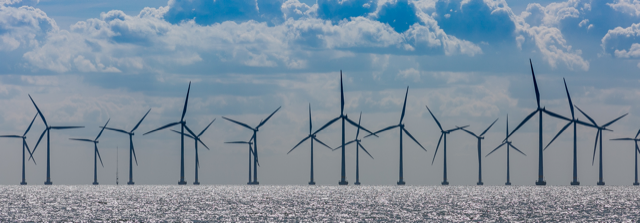The following op-ed article presents the author's personal viewpoints and does not necessarily reflect the opinions or positions of the publication, its editors, or its affiliated organizations. The author's perspectives are presented here to foster open dialogue and diverse discourse on the topic at hand. The publication does not endorse or take responsibility for the accuracy, completeness, or implications of the content within this article. Readers are encouraged to critically engage with the ideas presented and to form their own informed opinions based on a range of sources and perspectives. To contribute: https://www.nationalfisherman.com/about/contribute/
Fish and fishermen are used to making their way in or on the water. But, in its rush to develop offshore wind, the U.S. Government is throwing both fish and fishermen under the bus.
The U.S. should learn from Europe, which is decades ahead in developing offshore wind. The first offshore wind farm in Europe was built 32 years ago. Since then, more than 116 offshore wind farms have been built. Europe was extremely slow in addressing the effects of offshore wind on the marine environment, but in the last decade or so, they have been catching up.
In recent years, European scientists have developed and adapted various methods for qualifying changes to the marine ecosystem due to offshore wind development, beginning with establishing a baseline prior to construction. Surveys have been designed to examine stressors (physical presence and dynamic effects of turbines, acoustic, electromagnetic, etc.) and receptors (pelagic/benthic habitat, fish and fisheries, mammals, food chain, etc.), in many cases, establishing a grid covering the site of a future offshore wind farm and systematically surveying that grid, often extending the survey for some distance beyond its borders. In so doing, the scientists establish a critically important baseline of data that is needed to compare with data obtained when re-surveyed after an offshore wind farm is operational. In this way, it is possible to quantify the short, medium, and long-term effects of offshore wind on the marine ecosystem. It’s just common sense to do this. 1
Contrast this with the current U.S. approach. The Bureau of Ocean Energy Management (BOEM), the Federal agency that is the steward for all U.S. offshore properties, has repeatedly stated that they have no plans for requiring any offshore wind site to be surveyed prior to construction for the purpose of establishing a baseline of marine life. In so doing, the U.S. is simply failing to prepare for the potential effects of offshore wind on fish and fishermen, preferring to accept a highly uncertain outcome and ignoring important biological, ecological, and socioeconomic effects of offshore wind development.
There needs to be a recognition of the fact that large-scale offshore wind and the marine ecosystem are fundamentally incompatible. The U.S. needs to ensure that they are compatible.
Construction has already begun on some offshore wind farms on the U.S. East Coast. Some of these projects will be operational by approximately 2028. Already, some developers are in preliminary discussions with BOEM and the fishermen about future compensation to offset the negative effects to fishermen of offshore wind on their fisheries and livelihood. The developers will no doubt do their utmost to ensure that compensation remains as low as possible. The fishermen will be required to provide data to support their argument. But will they have the needed data? In this negotiation, the fish, the fishermen, and, indeed, the nation will be disadvantaged if no baseline data exists to quantify the effects of offshore wind on the marine ecosystem.
It's clear that the National Oceanic and Atmospheric Administration (NOAA), BOEM, and all the developers of offshore wind are aware of the need for baseline data. As stated in a recent paper, “Seeing the context for offshore wind development effects on fish and fisheries,” published in Oceanography (Gill et al. 2020) and also distributed by NOAA, “To obtain the most appropriate evidence critically requires improved baseline fisheries data and ongoing site and regional research monitoring...In the absence of appropriate knowledge, the effects of OWFs on fisheries is uncertain.”
Yet, instead of establishing baselines that would furnish this data, BOEM has been using existing data obtained from NOAA to determine the sitting of offshore properties in U.S. waters to be leased. The data they are using has been developed for use in stock assessments and for fishery management and is woefully unsuited to the purpose intended. As BOEM put it at a recent fisherman meeting, “That’s all the data we have.”
The Magnuson Stevens Act – the nation’s primary fish law – prohibits harm to fish and fish habitat from the impacts of harmful fishing gear and non-fishing activities such as dredging and energy development. That’s right: energy development. The Act’s conservation objectives align with the broader goals of protecting marine environments from potential adverse impacts. The National Environmental Policy Act (NEPA) states that it is the continuing responsibility of the Federal Government to adain the widest range of beneficial uses of the environment without degradation, risk to health and safety, or other undesirable and unintended consequences.
Humanity today finds itself in a historically unprecedented situation in which our technological capacity and the potential scale of our actions far exceed our predictive knowledge. It follows that if an activity raises threats of harm to the environment, precautionary measures must be taken.
The present abject lack of data on the effects of offshore wind on the marine ecosystem in the U.S. that is essential to our accurately quantifying both the positive and negative effects of offshore wind means we far exceed a minimal threshold of scientific uncertainty – and precautionary action must be taken. Establishing a baseline of marine life at these sites would enable us to understand the effects of offshore wind on the marine ecosystem, and these results, in turn, can be used to inform future decisions on the siting of oceanic properties yet to be leased. However, at present, the only “offset” identified to address negative outcomes from offshore wind development is potential compensation. This is, by any measure inadequate.
Compensation also raises the difficult question: How do we calculate the value of our fisheries to the nation for generations to come?
What is the cost to the U.S. for conducting a baseline survey prior to construction? The answer is the time needed to conduct the initial research – an extension of project timelines to conduct critical research. The developers themselves should pay the cost of the research – which will be a mere fraction of the total cost of a typical, large-scale offshore wind farm.
My organization represents approximately 3,000 U.S. commercial hand gear fishermen who sustainably harvest bluefin, yellowfin and bigeye tuna. These fish are highly migratory pelagic species and a valuable resource. BOEM, by their own admission, do not have any data on these fisheries. Research is desperately needed. Is the U.S. prepared to take the risk of discovering a few years from now that these fish have simply moved outside of the range of our fleets and an entire industry has been killed off?
Loss of or restricted access to traditional fishing grounds that overlap with offshore wind farms should be a realistic expectation, particularly if no action is taken in the planning stage to avoid this. Again, Europe has a long experience with this. In the North Sea, fishing is not allowed in and around offshore wind farms. In Germany and Belgium, fishing is banned in offshore wind farms. Large-scale floating offshore wind development in Scotland has identified a high probability that insurance liability will prevent fishing vessels from operating in the vicinity of floating offshore wind farms.2 There is much discussion in Europe on the issue of loss or restricted access by fishermen to their fishing grounds.3
In a rush to commission as many offshore wind projects as possible within the shortest period of time and absent needed research, we run the genuine risk of creating permanent damage to our marine ecosystem and to those who rely on it to provide a living.







